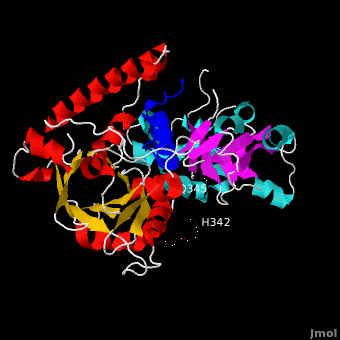Crystal structure of Agrobacterium tumefaciens VirE2 in complex with its chaperone VirE1: a novel fold and implications for DNA binding (3btp)
Publication Abstract from PubMed
Agrobacterium tumefaciens infects its plant hosts by a mechanism of horizontal gene transfer. This capability has led to its widespread use in artificial genetic transformation. In addition to DNA, the bacterium delivers an abundant ssDNA binding protein, VirE2, whose roles in the host include protection from cytoplasmic nucleases and adaptation for nuclear import. In Agrobacterium, VirE2 is bound to its acidic chaperone VirE1. When expressed in vitro in the absence of VirE1, VirE2 is prone to oligomerization and forms disordered filamentous aggregates. These filaments adopt an ordered solenoidal form in the presence of ssDNA, which was characterized previously by electron microscopy and three-dimensional image processing. VirE2 coexpressed in vitro with VirE1 forms a soluble heterodimer. VirE1 thus prevents VirE2 oligomerization and competes with its binding to ssDNA. We present here a crystal structure of VirE2 in complex with VirE1, showing that VirE2 is composed of two independent domains presenting a novel fold, joined by a flexible linker. Electrostatic interactions with VirE1 cement the two domains of VirE2 into a locked form. Comparison with the electron microscopy structure indicates that the VirE2 domains adopt different relative orientations. We suggest that the flexible linker between the domains enables VirE2 to accommodate its different binding partners.
Crystal structure of the Agrobacterium virulence complex VirE1-VirE2 reveals a flexible protein that can accommodate different partners., Dym O, Albeck S, Unger T, Jacobovitch J, Branzburg A, Michael Y, Frenkiel-Krispin D, Wolf SG, Elbaum M, Proc Natl Acad Sci U S A. 2008 Aug 12;105(32):11170-5. Epub 2008 Aug 4. PMID:18678909
From MEDLINE®/PubMed®, a database of the U.S. National Library of Medicine.
Here is the ribbon representation of the complex. The is colored blue. The of VirE2 is shown in red for and yellow for . The is shown in cyan for and magenta for . The inter-domain linker (residues 337-346) is shown as a black line. No electron density was observed for residues H342 and Q345 in the linker. Both domains form a [1], consisting of α-helices and β-strands and resulting in a donut shape with in the interior and at the exterior. This barrel has a unique topology, instead of 8 repeats of the (blue) of a (e.g. 8tim), 4 (yellow/red) are present in both the N- and C-terminal domains. The novel combination of the architecture and topology of this VirE2 domain allows its classification as a novel fold, termed the (4 ββαα motifs are shown in red, lime, yellow, and blueviolet, respectively).
Electrostatic interactions
between VirE1 (blue) and VirE2 are shown. Basic residues from both domains of VirE2 form electrostatic interactions (dashed lines) with acidic residues from VirE1. VirE2 N terminal domain is colored lime and the C terminal domain - blueviolet.

